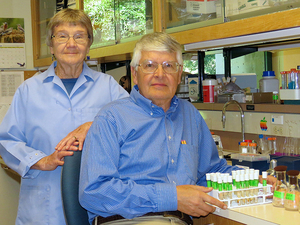Finding a way through a will

For nearly 40 years Emma Jean and Barry Bowman built our understanding of a part the cell called the vacuole. Now the retired researcher and emeritus professor are putting their department—Molecular, Cell, and Developmental Biology—in their will.
“We’re big supporters of the idea of doing science,” Barry Bowman says, while sitting on the couple’s deck overlooking westside Santa Cruz. “Especially basic science, science that doesn’t obviously have some medical practical role but could discover some fundamental things about how the living world works.”
For the Bowmans, that involved working side by side in UC Santa Cruz’s Sinsheimer Laboratories for most of their careers. Emma Jean (who goes by the nickname Rusty) Bowman performed experiments. Barry Bowman contributed to the research, while also serving in other professorial roles.
“I got to do the fun work,” Rusty Bowman says. “I got to be in the lab doing experiments, and Barry had to go to committee meetings, and teach students, and do all these other administrative things. But Barry got to be in the lab too.”
“We were in this rare situation of spending more time within 40 feet of each other than almost any other couple,” Barry Bowman says with a laugh.
Filling in the picture of an important protein
Step by step, they added to knowledge of a protein important for a wide range of biological functions. Vacuoles break down big molecules so the cell can use the pieces again. The process requires the inside of the vacuole to be acidic. Vacuolar ATPase moves acid through the membrane that surrounds the vacuole. Their research revealed how V-ATPase works, how it is structured, and how cells make it. This work helps us understand our ability to hear, how bones grow, and the function of kidneys, among other critical biological activities.
“If you can find something that’s genuinely new, that nobody in the world knows about, but that will be useful if discovered, and you can be the discoverer, that’s pretty fulfilling,” Barry Bowman says.
Over the years, they noticed a recurring challenge for their department. Gaps in funding would lead to gaps in research.
“You’d find these very bright young people who’d got that first grant and done well, and they were struggling to get that second one funded,” Barry Bowman says.
This meant sometimes a professor could no longer pay their lab technician. Rusty Bowman herself worked at times without a salary.
A gift to keep science moving
So not long after their retirement, the Bowmans decided to help solve the problem. They created an endowment funding the Barry and Emma Jean Bowman Fund for Research in Molecular, Cell, and Developmental Biology.
“It’s always been a question of what should we do with the money that we have. Rusty and I have no children, so we aren’t going to leave it to family or relatives,” Bowman says.
Eventually, their bequest will significantly expand the endowment. The funds will help support research during gaps between grants.
Barry Bowman says he hopes he can inspire other professors to establish planned gifts. A significant gift can help “nudge” your department in a direction you’d like to see it go, he adds with a smile.
“I would hope that some of my fellow faculty would do that,” he says. “If it has been your whole career you kind of want to see the university thrive.”